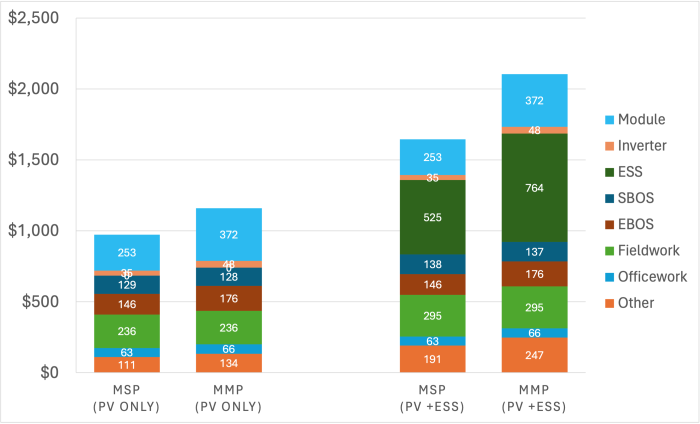Solar labor costs are high and rising, driving “astronomical” bids from EPCs, but market fundamentals, not the IRA’s prevailing wage requirements, are to blame, experts told Solar Builder Magazine.
The IRA requires all laborers and mechanics employed by a developer or subcontractor constructing, altering, or repairing a solar project over 1 MW to be paid at least the prevailing rates determined by the Department of Labor.
“We’re not expecting the prevailing wage to increase the system cost,” Brittany Smith, solar techno-economic analyst at the National Renewable Energy Laboratory (NREL), said.
Why? Because they unlock higher tax credits, she explained.
“Even though the prevailing wages are typically a little higher than the average wages that have been used in previous models from the Bureau of Labor Statistics, the system cost goes down because when you pay the prevailing wages, you get the full investment tax credit,” she explained. “If you don’t pay prevailing wages, you just get a 6% credit, but if you do pay prevailing wages, you get a 30% credit, which is 30% of the entire system cost. It’s not just 30% of the labor cost.”
NREL’s findings gel with what developers are seeing.
The IRA’s prevailing wage requirement is not driving the high cost of labor, said Sheldon Kimber, founder and CEO of Intersect Power, which develops, owns, and operates a portfolio of 2.2 GW of solar PV and 1.4 GWh of co-located storage. “We’re only getting quotes for labor that more than meet prevailing wage.” Intersect is active in two states, Texas and California, but Kimber doesn’t think that they’re outliers. “If anything, given the history of the industry, that’s where the biggest workforce should be.”
Unions aren’t to blame for rising labor costs either.
“If the union wage is the prevailing wage, all workers are going to be paid that whether they’re unionized or not,” Smith said. “I have heard developers say that even when they’re in an area that doesn’t have very much union unionization, and they’re offering a prevailing wage, they still aren’t able to recruit enough workers, so they have to offer a higher wage than the prevailing wage to even recruit non-unionized workers.”
What are prevailing wages?
Even if they are not the primary driver of high labor costs, employers still need to know what prevailing wages are.
“The prevailing wages are determined by either the county or the municipality, and so you have really high cost of living areas where the prevailing wage is a lot higher. In a given state, you can get prevailing wages that vary by a factor of two,” Smith said.
Adding to the complexity, “a lot of these prevailing wage determinations require fringe benefits to be paid, which is not something that’s typically been accounted for in previous cost models.”
Employers can look up the rates for various labor categories in a region on the Department of Labor website by following these instructions.
High labor costs are driving EPC rates up, up, up
Labor accounts for about 40% of the EPC contract, and labor costs have increased roughly 10-20% over the last few years, industry sources said.
“EPC pricing right now is astronomical,” said Kimber. “Without giving away anything proprietary, you’re seeing the kinds of numbers you would have expected to see at the peak of the commodity supply chain issues two to three years ago, but they’re almost entirely being driven by labor.”
Labor is the outlier, Kimber said. “You’ve got a decline in a lot of other pieces of equipment as inflation’s come down, but labor just has not. Labor has [risen] even further.”
Erika Symmonds, vice president of equity and workforce development at Solar Energy Industries Association (SEIA), said labor cost uncertainty is a big topic among members. “Particularly in the large-scale game, these projects are getting started a year or more before they’re actually getting into the ground, but you have to put that bid in way ahead of time. You have to understand your labor costs to bid correctly, otherwise you’re messing with your business.”

Inflation leads to overestimates
Part of what’s driving the escalation in prices is how estimators build inflation into their projections, Kimber said. If they pull from recent history and assume similar rates going forward, their estimates overshoot, and each year of high assumptions compounds the issue.
For example: Consider a project being constructed three years from now. If labor costs are quoted assuming 6% annual inflation, $100 of labor would be estimated to be $119 three years from now. But if actual inflation falls back to 3% after the first year, the cost would be only $112.
The conservative estimates are understandable, Kimber said. “Nobody wants to get burned three years from now if inflation goes back to 6%.”
Beware falling PPA prices
While EPC pricing is up, PPA prices are falling, and that’s probably not smart.
“I don’t understand how PPA prices are now starting to mellow. I haven’t seen the warnings that I would see to say that I can confidently deliver at these scales at those declining prices,” Kimber said. “All of those bidders that are coming in, and all of those customers that are striking on those bids, I think they have another thing coming. I would be cautious in this environment because labor is a very sticky input.”
Labor market inelasticity: What is it and why should you care?
Getting our economics geek on for a minute: a market is elastic when a change in price leads to a change in supply. For example, if Amazon increased warehouse workers’ pay from $15 to $20 an hour, and it resulted in many more people applying to work there, the market would be called elastic.
Solar, on the other hand, is inelastic – a market where a change in price doesn’t impact supply much – and solar’s labor market inelasticity should have us worried, according to Kimber. Increasing pay rates is not attracting enough workers quickly enough.
“The IRA is only responsible for this in so much as it may have pushed us into that inelastic point of the supply curve of labor,” Kimber said. “That’s why you’re seeing the rapid escalation in price. But the reality was, we were pretty close to that anyway.”
The reason is that it takes a lot more skill to build a solar plant than to work a warehouse job. “It takes two or three years to really train someone up from journeyman into being really knowledgeable.”
Adding to the challenge, it is a harder industry to recruit people into.
“It’s a job that people have to live away from their families, in many cases, because of the remote areas that we build utility-scale [projects in],” he said.
Addressing the growing labor shortage
The rising cost of labor is not only impacting the cost of building solar projects but also the ability to build a U.S.-based supply chain. The reemergence of U.S. manufacturing, ironically, will cause a very significant labor shortage, Kimber warns.
“We’re seeing a push from our government back toward domestic supply chains and domestic production. And this is just the beginning. It is a new golden age of labor,” Kimber said. “Tell your kids to go get an electrician’s certification and go join the IBEW and you can make a great living in this country building things.”
How to solve this? The industry has to get ahead of the labor issues and not expect the government to drive action, Kimber said. For people entering the industry, the IRA has an additional benefit: a requirement for more structured workforce training in the form of apprenticeships.
“You have to train more people, and you probably have to find different pools of labor, whether it be greater participation by underrepresented folks in the workforce or whether it be immigration. We as an industry are the tip of the spear for a much larger discussion,” Kimber said.
And finally, paperwork, please
As with most everything required by the government, there’s a paper trail needed to get the full ITC credit, even if the market conditions mean you are paying more than the prevailing wage. Employers are required to maintain three years of payroll records that reflect the hours worked in each classification and the actual wages and fringe benefits paid to each laborer and mechanic performing construction, alteration, or repair work on the facility.
Dej Knuckey is a contributor to Solar Builder. She is a journalist, author and freelance writer who has covered energy for publications in Australia and the U.S.
Tags: Inflation Reduction Act (IRA), Intersect Power, NREL, prevailing wages, SEIA, workforce



